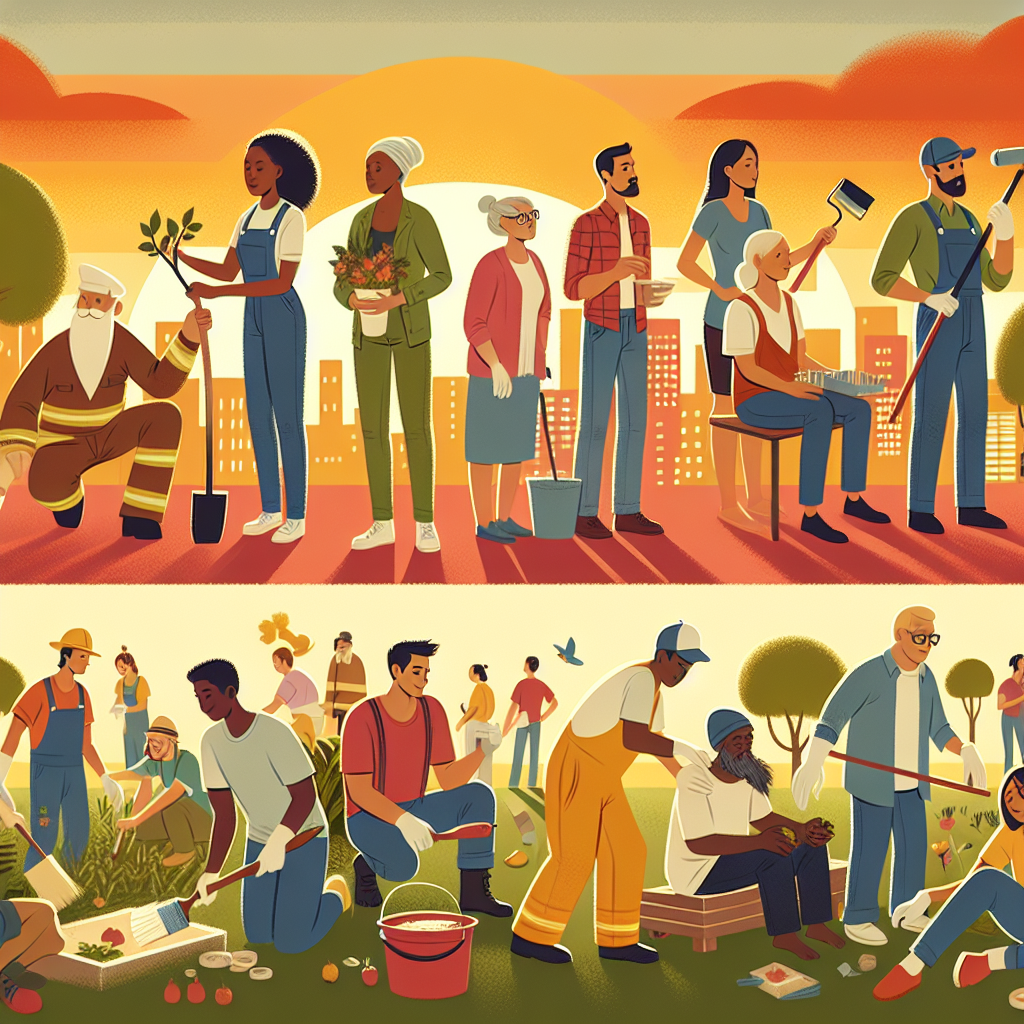Community Impact: How Teams Give Back
In 2025, the importance of community impact has surfaced as a fundamental principle guiding corporate responsibility. Teams and organizations, big and small, are seeking ways to give back to their communities, not only to foster goodwill but also to enhance their own internal culture and employee morale. When teams engage in community service, they create a ripple effect that benefits society at large, promoting a sense of unity and responsibility among team members while addressing local needs effectively. This article delves deep into the various ways teams are contributing to their communities, the benefits of these initiatives, and how such efforts can be structured for maximum impact.
Understanding Community Impact Through Team Initiatives
Community impact is increasingly becoming a focal point for organizations keen on making a difference. In 2025, teams are recognizing that their contributions can extend beyond the workplace and resonate throughout society. By taking part in various initiatives such as volunteerism, fundraising, and education outreach, organizational teams can provide direct benefits to those in their local communities. For instance, many companies are partnering with nonprofits, schools, and community organizations to tackle pressing issues such as food insecurity, education disparities, and environmental sustainability.
Engaging in community service provides teams an opportunity to leverage their skills to address specific local needs. For example, tech companies might offer their expertise to improve digital literacy among underprivileged youth, while healthcare organizations may focus on promoting awareness about mental health. These efforts not only benefit the community but also enrich the team’s experience, building a sense of purpose and belonging that can transcend workplace roles. Teams are increasingly seen as capable of mobilizing resources and expertise to create tangible change in their communities.
The Benefits of Team-Based Community Engagement
Engaging in community service as a team yields multiple benefits that transcend beyond simple good deeds. Firstly, team-building is significantly enhanced. When team members, regardless of their position, collaborate on projects outside their usual work responsibilities, they develop deeper relationships and trust. This is critical in fostering a positive workplace culture, leading to better collaboration and higher productivity in their regular duties. In 2025, organizations are increasingly recognizing this correlation between community service and improved internal dynamics, supporting initiatives that encourage employee participation.
Secondly, organizations that promote community involvement often see improved employee morale and satisfaction. As employees contribute to causes they are passionate about, they derive a sense of fulfillment and alignment with their company’s values. This intrinsic motivation translates into reduced turnover rates and increased loyalty to the organization. Moreover, businesses that actively demonstrate their commitment to community impact can enhance their brand reputation, attracting customers and clients who prioritize corporate social responsibility. This dual benefit of community engagement—internally fostering team spirit and externally building credibility—is shaping the very essence of successful organizations in 2025.
Innovative Approaches to Community Giving
In 2025, technology plays a vital role in shaping how teams engage with their communities. Remote and hybrid work models have prompted organizations to explore innovative approaches for giving back. Virtual volunteering, for instance, has gained traction, allowing employees to contribute their skills remotely. Webinars, online mentorship programs, and digital advocacy campaigns enable employees to connect with community organizations without being geographically constrained. This flexibility means that more employees can participate, regardless of their location.
Similarly, the emergence of social enterprises has led teams to explore collaborative projects that create sustainable change. Businesses are partnering with social enterprises to tackle community issues such as economic disparities or environmental challenges. These partnerships often lead to unique and innovative solutions that can have a lasting impact. For example, a manufacturing company might collaborate with a local environmental group to create eco-friendly products, benefiting both their business and their community simultaneously. In 2025, such collaborations are seen not just as a trend but a standard practice, reinforcing the idea that impactful community engagement is essential for long-term success.
Furthermore, the rise of employee engagement platforms has revolutionized how teams can initiate and track their community impact. Companies are now utilizing technology to highlight their social responsibility initiatives, allowing employees to select causes they care about and contribute in meaningful ways. By providing a structured way to engage, these platforms enhance employee participation and track the collective impact made by teams, fostering a culture of giving back that is appreciated both internally and externally.
Metrics and Measurement of Community Impact
In the age of data-driven decision-making, measuring community impact has become essential for organizations wanting to understand their contributions’ efficacy. In 2025, teams are adopting various metrics to evaluate success in community service initiatives. One way organizations quantify impact is by tracking volunteer hours and projects completed. Additionally, measuring the reach of initiatives—like the number of individuals served, resources distributed, or educational workshops held—provides tangible data on community engagement.
Moreover, employee feedback is crucial in understanding the qualitative impact of community service. Surveys assessing employee satisfaction after volunteering can highlight the emotional benefits derived from these activities. Teams often utilize focus groups to gather insights on how community initiatives have influenced employee morale and cohesion, allowing companies to refine their strategies based on direct feedback. By combining quantitative measures with qualitative insights, organizations can strive for continuous improvement in their community engagement efforts.
Finally, showcasing the impact through storytelling has become a powerful tool for organizations in 2025. By sharing success stories and case studies highlighting positive outcomes from their community involvement, companies can inspire their employees and potential stakeholders. These narratives resonate emotionally and highlight the authenticity of the organization’s commitment to community impact. As more companies embrace transparency, sharing impact stories becomes a vital component in fostering trust and engagement among employees and the community alike.
Future Trends in Community Impact Initiatives
As we move deeper into 2025 and beyond, evolving trends in community impact initiatives promise to shape how teams engage with their communities. One significant trend is the integration of sustainability into community efforts. Modern organizations recognize that environmental responsibility must be part of their social impact strategies. Initiatives focusing on reducing carbon footprints, supporting recycling programs, and advocating for clean energy are becoming increasingly significant. Teams are expected to spearhead sustainability efforts in their communities, showcasing a commitment not just to people but also to the planet.
Moreover, inclusivity and diversity are central themes emerging in community impact initiatives. Teams are prioritizing projects that address inequities within marginalized communities, ensuring that their efforts promote social justice and equality. Organizations can expect to champion causes that empower underrepresented groups, working alongside communities to cultivate an environment of inclusivity and shared prosperity. This focus on inclusiveness goes hand-in-hand with employee engagement, as team members feel a greater sense of purpose when their community work aligns with broader societal goals.
Finally, the reliance on partnerships is anticipated to broaden even further. As challenges facing communities become more complex, organizations will likely forge more alliances with governmental agencies, nonprofits, and other businesses to leverage collective resources. This collaborative approach not only enhances the scope of community projects but also fosters holistic solutions that address root causes rather than merely treating symptoms. Teams in 2025 are set to become catalysts for change, driving collaborative efforts that amplify the impact of their community engagement initiatives.
Conclusion
The significance of community impact as a vehicle for social change and team engagement cannot be overstated in 2025. As organizations and their teams develop novel approaches to give back, they are seeing tangible benefits in employee morale and company reputation. By understanding the critical factors involved in meaningful community engagement—such as belonging, innovation, metrics, and future trends—organizations can enrich their impact effectively. Ultimately, community impact not only cultivates a sense of purpose within teams but also enhances the world around us, creating a cycle of positive change that benefits everyone involved.
FAQs
1. What types of community impact initiatives can teams engage in?
Teams can participate in various activities, including volunteering, fundraising, mentoring, environmental cleanup, and educational outreach. The focus should align with both the company’s values and the community needs.
2. How can organizations measure their community impact?
Organizations can measure community impact through metrics such as volunteer hours, number of individuals served, feedback from employees, and storytelling that highlights success stories and outcomes from their initiatives.
3. Why is it important for teams to engage in community service?
Engaging in community service fosters team building, improves employee morale, enhances brand reputation, and aligns company values with broader societal goals, leading to a more cohesive and motivated workforce.
4. What role does technology play in community impact initiatives?
Technology enables virtual volunteering, collaboration with social enterprises, and the use of engagement platforms to track involvement and impact, making it easier for teams to participate and showcase their community contributions.
5. How can companies ensure their community impact initiatives are inclusive?
Companies can prioritize projects that empower marginalized groups, seek input from diverse community members, and ensure that their initiatives foster societal change and contribute to equity and inclusion.












